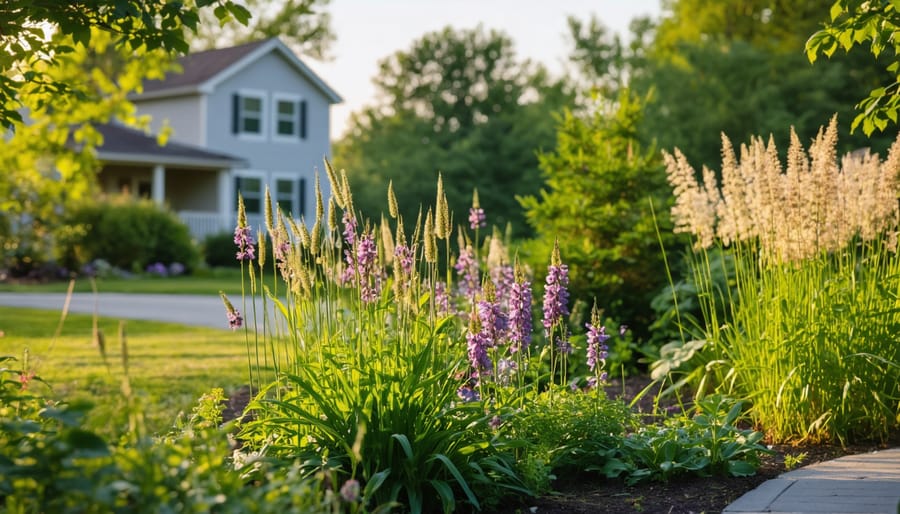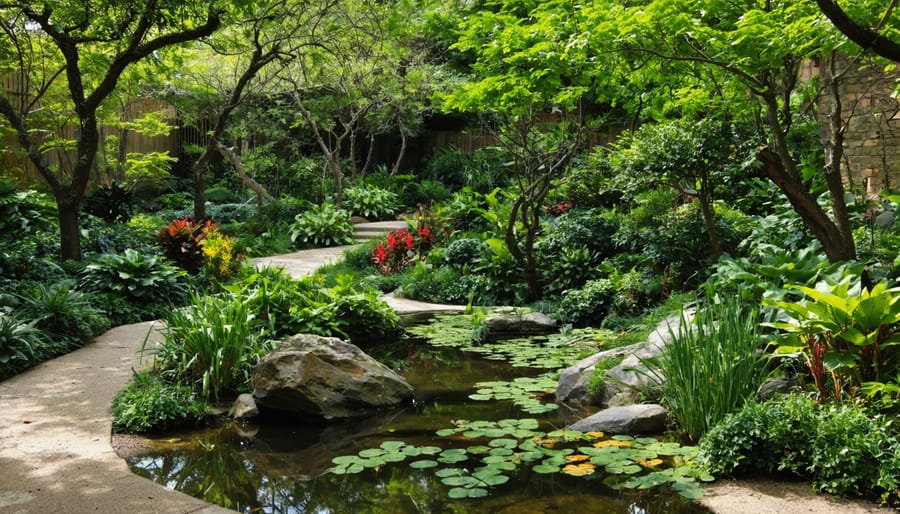Transform concrete jungles into thriving ecosystems by integrating native plant corridors along building facades, creating vertical gardens that reduce urban heat islands, and designing permeable surfaces that naturally filter stormwater. Modern urban farming practices prove that cities can become regenerative environments, supporting both human communities and local wildlife. Green infrastructure solutions, from rooftop gardens to bioswales, merge architectural innovation with ecological principles to create resilient urban spaces that combat climate change while enhancing quality of life. By reimagining cities as living organisms, urban ecological design revolutionizes how we build, transforming traditional gray infrastructure into dynamic, sustainable landscapes that work in harmony with nature. These solutions not only address environmental challenges but also create beautiful, functional spaces where communities thrive and biodiversity flourishes.
Balancing Nature and Urban Living
Working with Your Local Ecosystem
Working with your local ecosystem is like partnering with nature itself. Native plants are perfectly adapted to your area’s climate and soil conditions, making them easier to maintain and more resilient. These plants have evolved alongside local wildlife, creating natural habitats that support birds, butterflies, and beneficial insects.
Start by observing what naturally grows in your neighborhood and researching plants native to your region. Local nurseries and botanical gardens are excellent resources for discovering suitable species. Consider incorporating different layers of vegetation – from ground covers to shrubs and trees – to create a diverse habitat that mimics natural ecosystems.
Pay attention to wildlife patterns in your area. Are there specific birds that migrate through? What pollinators are common? Design your space with these creatures in mind by including food sources, water features, and shelter opportunities. Even small urban gardens can become vital stepping stones in the larger ecological corridor.
Remember that successful ecological design isn’t about controlling nature but rather creating conditions where it can thrive. By choosing the right plants and understanding local wildlife needs, you’re contributing to a healthier urban environment while enjoying a more sustainable and vibrant garden.
Smart Water Management
In urban settings, implementing efficient water management systems is crucial for creating sustainable landscapes. Rain gardens serve as natural collection points, allowing water to slowly seep into the ground while filtering pollutants. These beautiful depressions can feature native plants that thrive in varying moisture conditions, adding both functionality and visual appeal to your space.
Consider installing permeable pavements in walkways and driveways, which allow rainwater to penetrate the surface rather than creating runoff. Complementing these features with rain barrels or cisterns helps capture precious rainfall for later use during dry spells. Many urban gardeners find that incorporating drip irrigation systems reduces water waste while keeping plants healthy and thriving.
Smart water management isn’t just about conservation – it’s about mimicking nature’s water cycle in our urban environments. By incorporating bioswales along property boundaries or creating small retention ponds, you’re not only managing water effectively but also creating habitats for local wildlife. Remember to position plants strategically, grouping those with similar water needs together to maximize irrigation efficiency.
Design Elements That Make a Difference
Vertical Gardens and Living Walls
Vertical gardens and living walls represent an innovative solution to the challenge of limited green space in urban environments. These eye-catching installations transform blank walls into thriving ecosystems, creating a striking visual impact while offering numerous ecological benefits. By growing upward instead of outward, they maximize the use of available space and contribute to urban biodiversity.
The benefits of vertical gardens extend beyond aesthetics. They act as natural insulators, reducing building energy costs by up to 23% in summer months. These living walls also improve air quality by filtering pollutants and producing oxygen, while their dense foliage helps reduce urban noise pollution by up to 10 decibels.
Creating a vertical garden can be as simple or complex as you desire. Start with pocket planters or modular systems for easy maintenance. Choose plants that thrive in vertical conditions, such as ferns, succulents, herbs, and climbing vines. Consider factors like sun exposure, irrigation needs, and seasonal changes when selecting your plants.
Maintenance is key to a successful vertical garden. Install an efficient irrigation system – drip systems work particularly well for vertical installations. Regular pruning, fertilizing, and plant health monitoring ensure your living wall remains vibrant year-round. For beginners, start small with a test area before expanding to larger installations.
Remember that vertical gardens contribute to urban heat island reduction and support local wildlife, making them an essential component of sustainable city design.

Permeable Surfaces and Rain Gardens
Permeable surfaces and rain gardens offer elegant solutions to urban stormwater management while creating vibrant, living spaces in our cities. Unlike traditional concrete or asphalt, permeable materials like gravel, specially designed pavers, and porous concrete allow rainwater to seep naturally into the ground, reducing runoff and replenishing groundwater supplies.
Rain gardens take this concept further by transforming low-lying areas into beautiful, functional landscapes. These shallow depressions, filled with deep-rooted native plants, naturally collect and filter rainwater from roofs, driveways, and streets. Popular plant choices include cardinal flower, blue flag iris, and swamp milkweed, which not only manage water effectively but also attract butterflies and beneficial insects.
Creating your own rain garden starts with selecting the right location, typically 10 feet from your home’s foundation. The garden should be about 6 inches deep with gently sloping sides, making it both practical and visually appealing. Layer the bottom with a mix of sand, topsoil, and compost to ensure proper drainage and plant health.
The benefits extend beyond water management – these features reduce the urban heat island effect, provide habitat for local wildlife, and add natural beauty to our neighborhoods. Whether you’re working with a small yard or a larger community space, incorporating permeable surfaces and rain gardens helps create resilient, sustainable urban environments that work in harmony with nature.

Wildlife-Friendly Features
Urban gardens can become vibrant ecosystems by creating wildlife-friendly spaces that welcome local fauna. Start by incorporating native plants that provide food and shelter for birds, butterflies, and beneficial insects. A mix of flowering perennials, berry-producing shrubs, and trees creates a layered habitat that supports diverse wildlife populations.
Water features, such as small ponds or bird baths, are essential elements that attract and sustain urban wildlife. Even a simple shallow dish with fresh water can become a vital resource for local birds and insects. Consider adding partially submerged rocks or branches to create safe landing spots for smaller creatures.
Install nesting boxes and insect hotels at various heights to provide safe havens for urban wildlife. These structures offer crucial shelter during harsh weather and breeding seasons. Leave some areas of your garden slightly wild, with fallen leaves and natural debris, as these spaces become microhabitats for beneficial insects and small mammals.
Reduce artificial lighting to protect nocturnal species and maintain natural behavioral patterns. When lighting is necessary, use downward-facing fixtures and warm-colored bulbs to minimize disruption to wildlife. Remember to avoid using chemical pesticides, as these can harm beneficial insects and disrupt the natural food chain in your urban ecosystem.
Sustainable Materials and Maintenance
Recycled and Local Materials
When designing an eco-friendly urban landscape, the materials you choose play a crucial role in reducing environmental impact. Recycled materials offer a sustainable alternative to new products while adding unique character to your space. Consider incorporating reclaimed brick or stone from local demolition sites – these materials bring history and charm while preventing construction waste from entering landfills.
Local materials are another excellent choice for sustainable hardscaping. Using stones, gravel, or wood sourced within your region reduces transportation emissions and supports local businesses. Many areas have quarries or lumber yards that offer native materials perfectly suited to your climate and architectural style.
Innovative recycled products are becoming increasingly available for urban landscaping. Permeable pavers made from recycled plastic, rubber mulch from old tires, and composite decking from reclaimed wood and plastic all offer durability while giving new life to waste materials. These options often require less maintenance than traditional materials and can handle urban challenges like heavy foot traffic and variable weather conditions.
When selecting materials, consider their full lifecycle impact. Look for suppliers who prioritize sustainable practices, and don’t forget to check salvage yards and architectural recycling centers – you might find unique pieces that become focal points in your design. Remember that using recycled and local materials not only benefits the environment but often creates more interesting and authentic spaces with their own stories to tell.
Natural Maintenance Methods
Maintaining an urban ecological design doesn’t have to be complicated or resource-intensive. By implementing natural maintenance methods, you can keep your space thriving while minimizing environmental impact.
Start by embracing nature’s own cycles. Let fallen leaves decompose naturally to enrich soil and provide habitat for beneficial insects. Create your own compost from kitchen scraps and yard waste to feed your plants without synthetic fertilizers. Hand-pulling weeds or using mulch for weed suppression eliminates the need for chemical herbicides.
Water conservation plays a crucial role in sustainable maintenance. Install rain barrels to collect rainwater, and use drip irrigation or soaker hoses to deliver water directly to plant roots. Grouping plants with similar water needs helps optimize irrigation efficiency.
Consider introducing beneficial insects like ladybugs and praying mantises to control pest populations naturally. Companion planting can also help – marigolds deter many garden pests, while herbs like basil and mint attract pollinators.
Maintain tools manually when possible, using push mowers instead of gas-powered equipment. Keep pruning tools sharp to make clean cuts that heal quickly. Remember, a well-planned ecological design actually requires less maintenance over time as natural systems establish themselves and create their own balance.
Getting Started with Your Project
Assessment and Planning
Before diving into your urban ecological project, it’s essential to thoroughly assess your space and develop a comprehensive plan. Start by observing your area at different times of day to understand light patterns, noting which areas receive full sun, partial shade, or complete shade. This information will be crucial for plant selection and placement.
Make a detailed inventory of existing features, including structures, trees, utility lines, and drainage patterns. Pay special attention to soil quality by conducting basic soil tests to determine pH levels and nutrient content. Don’t forget to note any existing wildlife activity – these are valuable indicators of your space’s current ecological health.
Consider your local climate zone and typical weather patterns. Research native plant species that thrive in your area and support local wildlife. Map out water sources and consider how rainwater naturally flows through your space. This understanding will help you design sustainable irrigation systems.
Create a scaled drawing of your space, marking all existing elements and potential challenges. Use this as your base map to sketch different design options. Consider your goals: Do you want to create a wildlife habitat? Grow food? Reduce water usage? Your objectives will guide your design choices.
Remember to check local regulations regarding permits and restrictions. Many urban areas have specific guidelines about plant height, water features, and hardscape modifications. Planning with these considerations in mind will save you time and potential headaches later.

Finding Professional Help
Finding the right professional for your urban ecological design project is crucial for achieving sustainable and beautiful results. Start by looking for landscape designers who specialize in ecological or sustainable design and have experience with urban environments. Check their portfolios for projects similar to your vision, paying special attention to those that incorporate native plants and sustainable water management systems.
When interviewing potential designers, ask about their approach to ecological principles and how they balance aesthetics with environmental benefits. Key questions should address their experience with local regulations, knowledge of native plant species, and understanding of urban challenges like limited space and microclimate considerations.
Look for professionals who hold certifications in ecological design or sustainable landscaping. Organizations like the Association of Professional Landscape Designers (APLD) and the Ecological Landscape Alliance can be excellent resources for finding qualified professionals in your area.
Before making your final decision, request references from past clients and visit some of their completed projects if possible. Pay attention to how well the designer listens to your ideas and concerns, and whether they can clearly explain their design process and environmental strategies.
Consider their communication style and willingness to collaborate with you throughout the project. The best ecological designers will not only create a beautiful space but will also educate you about maintaining your urban ecosystem for years to come.
Urban ecological design offers an exciting opportunity to transform our cities into vibrant, sustainable spaces that benefit both people and nature. By incorporating native plants, creating wildlife corridors, and implementing sustainable water management systems, we can build urban environments that thrive alongside natural ecosystems. Remember, every small step counts – whether you’re greening a tiny balcony or redesigning a community park. Start by choosing one project that resonates with you, like installing a rain garden or creating a pollinator-friendly space. Connect with local gardening groups and environmental organizations to share resources and knowledge. Together, we can create healthier, more resilient cities that future generations will enjoy. Your urban garden, no matter how small, is part of a larger movement toward sustainable city living.




